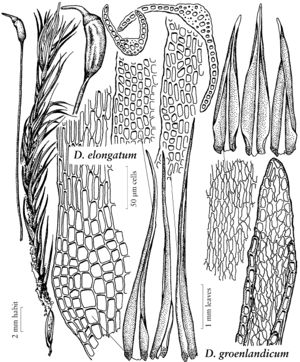Dicranum groenlandicum
Muscol. Recent., suppl. 4: 68. 1818,.
Plants in dense tufts, light green, glossy. Stems 4.5–10 cm, tomen-tose throughout with brown to red rhizoids. Leaves erect-spreading, erect-appressed when dry, smooth, (2.5–)3–4(–6.5) × 0.3–0.5 mm, from an ovate-lanceolate base to a tubulose subula, narrowly obtuse at apex, rarely acute, sometimes apical leaves of stems julaceous; margins entire; laminae 1-stratose, occasional 2-stratose regions near costa in proximal part of leaf; costa subpercurrent to percurrent, 1/10–1/6 the width of the leaves at base, smooth, abaxial ridges absent, with a row of guide cells, two well developed and thick stereid bands (5–6 cells thick), adaxial epidermal layer of cells not differentiated, the abaxial layer usually with a few cells enlarged; cell walls between lamina cells slightly bulging; leaf cells smooth; alar cells 1- or 2-stratose, well-differentiated, not extending to costa; proximal laminal cells elongate-sinuose, strongly pitted, (36–)54–65(–98) × (2–)5–6(–9) µm; distal laminal cells (11–)17–26(–42) × (2–)5–6(–12) µm. Sexual condition dioicous; male plants as large as females; interior perichaetial leaves abruptly short-acuminate, convolute-sheathing. Seta 1.5–2 cm, solitary, yellow to reddish yellow. Capsule 1.5–2 mm, nearly straight and erect to slightly arcuate, ± striate when dry, yellowish brown; operculum 1–1.7 mm. Spores 14–19 µm.
Phenology: Capsules mature in summer.
Habitat: Arctic or alpine tundra, soil, humus or rocks, sometimes in bogs and fens
Elevation: 10-3800 m
Distribution
Greenland, Alta., B.C., Man., Nfld. and Labr. (Nfld.), N.W.T., Nunavut, Ont., Que., Yukon, Alaska, Colo., N.Y., Europe, Asia.
Discussion
Dicranum groenlandicum is sometimes not very distinct, often being difficult to separate from its nearest relative, 19. D. elongatum. For distinctions see the discussion under that species.
Selected References
None.
